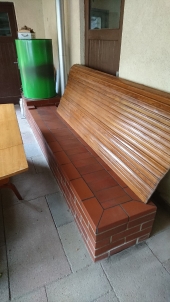Since the patio is roofed, could not led the flue straight up.
It starts about 5cm / 2" above the bottom of the bell in the corner where the bell connects to the slightly deeper housing of the core (open 270° horizontally and 180° vertically).
From there it goes some 2m / 85" up and then another 7feet almost horizontal with only 7cm/2.5" raise. Depending of the wind I can add another ellbow with 1m / 40" extra vertical.
This last rise makes no difference in draft, but keeps the steam from being blown under the roof.
The bench is a little on the big side for this small 4" BB.
Therefore the heater starts slow, especially in wet or damp weather with temps above 10°C/50F.
When the bench is warm at the heater side (about 40mins after a cold start) it got lots of draft.
After an hour the whole bench is warm and the fire is almost out.
My firewood comes from the garden and the forrest behind it, mainly magnolia, pine, birch and some linden and beech.
The first three got quite some oils and resin so the inside of the bench is black.
The effect is heavier, when reloading the heater before the coals are burned out: The heat gassifies the oils but there is not enough oxygen to burn all of it.
So wait for it.








 )
)


 : 94in long by 13 high by 10 wide.
: 94in long by 13 high by 10 wide.
 . When I fire it up it is always stone cold (sometimes even freezing). Nevertheless, the barrel heats up in less then 5mins and the bench is handwarm at the near side 40mins later. After 1hour the whole thing is warm to the touch and the fire is all embers covered with white ash. Without more wood it will cool down to lukewarm in about 2hours (a little faster, if it's really cold outside).
. When I fire it up it is always stone cold (sometimes even freezing). Nevertheless, the barrel heats up in less then 5mins and the bench is handwarm at the near side 40mins later. After 1hour the whole thing is warm to the touch and the fire is all embers covered with white ash. Without more wood it will cool down to lukewarm in about 2hours (a little faster, if it's really cold outside).

